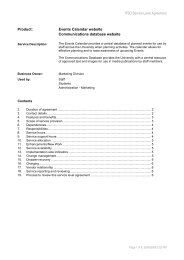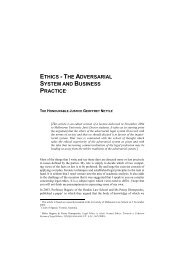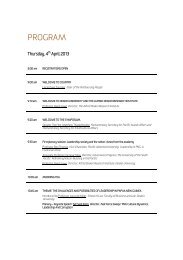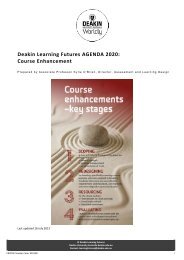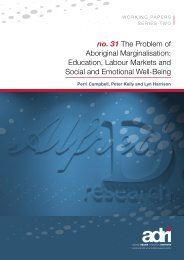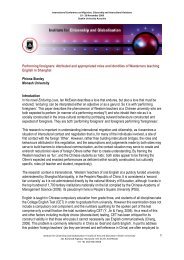Mister Myths - Deakin University
Mister Myths - Deakin University
Mister Myths - Deakin University
Create successful ePaper yourself
Turn your PDF publications into a flip-book with our unique Google optimized e-Paper software.
Men and shopping<br />
Part 1: Exploring the ‘<strong>Mister</strong> <strong>Myths</strong>’<br />
The Retail Acumen Series<br />
By Stephen Ogden-Barnes (Retail Industry Fellow, <strong>Deakin</strong> <strong>University</strong>)<br />
2
Contents<br />
Contents ...................................................................................................................... 1<br />
About the author ......................................................................................................... 2<br />
Introduction ................................................................................................................. 3<br />
Myth or reality? ........................................................................................................... 3<br />
Man, Woman, different ................................................................................................ 4<br />
<strong>Mister</strong> <strong>Myths</strong> ................................................................................................................ 5<br />
Myth-busted? ............................................................................................................ 16<br />
Conclusion ................................................................................................................ 17<br />
References ................................................................................................................ 18<br />
1
About the author<br />
Steve Ogden-Barnes is Retail Industry Fellow at the <strong>Deakin</strong> <strong>University</strong> Graduate<br />
School of Business. Following a diverse career in UK retailing, Steve moved to<br />
Australia to specialise in retail education, industry engagement and research. Steve<br />
has recently completed a PhD focusing on marketing decision-making and sales<br />
promotion management in the Australian retail marketplace. In addition, he is<br />
supporting the development of the new Graduate Certificate of Retail Management<br />
at <strong>Deakin</strong>, due to be launched in 2012. Steve is a regular commentator on retail and<br />
consumer issues, for the Australian Financial Review, The Age, The Australian, the<br />
Herald Sun, BRW, ABC Radio and Today Tonight.<br />
2
Introduction<br />
“Shopping makes men impotent”. (New India Times, July 5 th 2010). [1]<br />
We’ve all seen them. We all know them. Half of us may even be them: men who hate<br />
to go shopping. In recent years, the subject of men and shopping has become the<br />
stuff of urban myth and legend: ‘Men aren’t good shopping’. ‘Men don’t like<br />
shopping with their partners’. ‘Men are mission shoppers’. ‘Men are ‘hunter-gathers<br />
at the mall’. ‘Men buy more from attractive assistants’. ‘Shopping is for girls’. ‘Men<br />
won’t ask for help or directions in stores’. ‘Men experience stress when buying gifts<br />
for partners at Christmas’. ‘Men hate shopping’. ‘Men are only happy in hardware<br />
stores looking at tools’. The list of mainstream media revelations in relation to male<br />
shopping appear endless and fuels the stereotype of the reluctant, hesitant - or<br />
absent - male shopper. The debate centres inevitably on the differences between<br />
males and females in relation to their shopping experiences, forming a rich source of<br />
reference for script writers, editors, journalists, industry commentators, comedians<br />
and bloggers. This paper, the first of two focusing on men and shopping explored the<br />
myths and realities surrounding men and shoppers, to help retailers better<br />
understand what could well be a significant and potentially underserved market<br />
segment in the retail economy.<br />
Myth or reality?<br />
It’s easy to buy into the ‘men hate shopping’ story. A cursory look through the<br />
popular press reveals a rich evidence base of reports, surveys and studies which<br />
portray men as victims - rather than beneficiaries of - modern consumer culture.<br />
Shopping for them means exposure to a bewildering world of suggestion, aspiration,<br />
endless choice and impossible decision. It’s a world which is portrayed as somehow<br />
beyond their powers of interpretation and comprehension, a world which has evolved<br />
more quickly than they have and they just don’t fit in. The modern male is often<br />
portrayed as being about as controlled, comfortable and confident shopping as a<br />
caveman would be flying a space shuttle. One wrong turn in the department store<br />
and you could find yourself in the lingerie department, which will cause inevitable<br />
embarrassment. Over 20,000 items for sale in the average supermarket. One<br />
3
hundred and eighty different types of muesli available. How can a guy possibly<br />
choose?<br />
Figure 1: black or brown? Is less choice more appealing to male shoppers?<br />
Man, Woman, different<br />
It’s different for women course. Women love shopping. Women are compulsive<br />
shoppers who turn a shopping trip into a social occasion, inviting friends, family (and<br />
reluctant male partners) along for the ride. But is it myth or reality? Are men really<br />
store-adverse? Are shopping centres really female domains in which men will always<br />
feel isolated, alienated, uncomfortable or embarrassed? Is their place at home,<br />
waiting outside in the car, or sitting outside the store, literally ‘on the bench’? Is<br />
browsing somehow emasculating? Is shopping reluctantly with a spouse the final<br />
descent into hen-pecked husband hell? Or do some retailers simply need to work<br />
harder to increase their man-appeal, increasing both customer volumes and sales as<br />
4
a consequence? Firstly however, it’s important to separate myth from reality and<br />
explore the so-called <strong>Mister</strong> <strong>Myths</strong> which may prevent retailers capitalising upon the<br />
male dollar.<br />
<strong>Mister</strong> <strong>Myths</strong><br />
<strong>Mister</strong> Myth #1: Men hate shopping<br />
“Not all men hate shopping. Most men enjoy shopping, what they do not like is<br />
having to wait while their wife or girlfriend takes forever to decide what they are<br />
going to buy. Men can shop fast. They usually know what they want, find it and buy<br />
it. They do not need to go through a lot of items to decide what is best looking. Men<br />
do not like to wait. They do like to shop”.<br />
Source: www.answers.com. [2]<br />
“Men don't hate shopping, they just shop for different things. Have you ever had to<br />
wade through acres of tractors, with a man who has no intention of buying? Have<br />
you visited every lawn and garden store in a hundred mile radius, looking for that<br />
perfect grill? I have, with several farmers”.<br />
Source: www.hubpages.com. [3]<br />
Not all men hate shopping, any more than all women love shopping. The ‘men hate<br />
shopping’ <strong>Mister</strong>-Myth seems readily to be readily accepted as a cornerstone of the<br />
male-female consumer relationship. Tales abound of reluctant men being dragged<br />
around shops against their will, oblivious to the benefit of the experience, with the<br />
man-crèche emerging again as a popular solution. As one homewares retailer who<br />
opened a man-crèche in the UK noted:<br />
"It's well known that men's shopping patience threshold is perhaps a tenth of that of<br />
women, so we've decided to help avoid domestic disputes by the duvets and battles<br />
in the bathroom, by giving them an area for a break."<br />
Source: Manchester Evening News. [4]<br />
5
Figure 2: A typical male shopper sitting it out?<br />
However, men can be big, big spenders. Take Metrosexuals. The personal care<br />
market for males has grown exponentially in recent years. In 2005 for example,<br />
L’Oreal reported that men’s skincare was its fastest growing sector. L’Oreal’s Diesel<br />
brand, launched in 2009 quickly achieved market leading status in the UK, and<br />
became the no. 4 brand in the US [5]. This proves perhaps that new product<br />
development isn’t entirely wasted on men, and as we’ll discover later may actually be<br />
most effective when directed towards men. The company reports that the market for<br />
men’s cosmetics is growing three times faster than the global average, with Asia-<br />
Pacific accounting for 51% of the market. In Japan, sales of men’s cosmetics grew<br />
17% in 2008. Euromonitor forecast that the worldwide sales of men’s personal care<br />
products will grow 12 percent to $29.3 billion between 2008 and 2013, with demand<br />
strongest in the emergent retail economies of China and Brazil [6]. Leading global<br />
fashion retailer Zara hasn’t left men out of the shopping equation, introducing men’s<br />
ranges alongside its core female offer in 2007. The global market for luxury watches<br />
6
- traditionally a male dominated ‘trophy’ sector has surged in recent years, most<br />
notable in Asia-Pacific and with strong potential market reported in India.<br />
Figure 3: Luxury watches offer strong man appeal in India<br />
7
Gay men like to shop it seems. In the UK, it is estimated that the ‘pink pound’ is<br />
worth £6bn per year, and in the US in 2006 the value of the pink dollar was<br />
estimated to be worth US$641 billion [7]. The common view seems to be that gay<br />
couples, being often childless, are more affluent that their straight counterparts, more<br />
fashion and appearance conscious and are therefore an attractive and distinct<br />
market segment.<br />
Anyway, if there’s no one to do the shopping for you, what choice do you have? Men<br />
are marrying later in life, and divorce is more commonplace. That could mean that a<br />
lot more men are having to shop for themselves as their relationship status changes.<br />
That isn’t to suggest that shopping is done for men by wives but not by girlfriends,<br />
but more ‘single-time’ means more shopping time. Men may not love it, but they<br />
have to do it, and every time you get divorced, there’s more stuff to buy!<br />
Figure 4: An ironic online offer? www.menhateshopping.com<br />
8
<strong>Mister</strong> Myth #3: Men hate shopping because they’re hunter-gathers<br />
Homo Saipan has engaged in hunter-gather activities for over 200,000 years,<br />
although admittedly hunting is less of a feature of your average guy’s day than it<br />
used to be. But what images and mindsets and stereotypes does the term ‘hunter-<br />
gather’ actually convey? The steely-eyed male predator going in for the big kill? The<br />
decisive pounce? The fatal blow? The ritual of the hunt? The triumphant return to<br />
camp, bringing meat to the family table? The women of the village preparing the<br />
catch, and collecting produce close to camp? In relation to retail, the hunter-gather<br />
distinction is used seemingly to explain both the lack of patience men demonstrate in<br />
relation to shopping and their general disdain for the activity in particular, almost as if<br />
it’s somehow beneath them - it’s a bit like asking a Maasai warrior to stay at home<br />
and learn knitting. Consider these justifications for example:<br />
“As shoppers made their last minute dash for Christmas gifts yesterday, a study has<br />
revealed men and women display a "hunter-gatherer" mentality towards shopping.<br />
Men are happy to leave shopping to the last minute because they see the exercise<br />
as a hunter might have done - leaving the kill to the last minute to make sure the<br />
meat didn't go off. Women behave like gatherers by preparing ahead of time”.<br />
Source: Daily Telegraph (Aus) 24/12/2009. [8]<br />
“The idea that men hate shopping while women love it is probably the most<br />
defensible among all gender stereotypes. Economics would be very different if Adam<br />
Smith had been Eve Smith. Male-driven economics is largely about the stuff the<br />
seller wants, money. This is by definition as featureless and abstract as possible. On<br />
the buying side though, there is a great deal of complexity, variety, and delight in<br />
leisurely and nuanced selection”.<br />
Source: www.ribbonfarm.com, 28/05/2009. [9]<br />
9
This theory has also attracted significant academic interest and support. Consider<br />
these observations from researchers at Brunel Business School:<br />
“Female ‘gathering’ involves searching, comparing alternatives, finding the best<br />
value and taking pride in shopping. Shopping is seen as a satisfying activity in<br />
itself...men, on the other hand, see shopping as a mission, going straight for what<br />
they want in a purposeful way. The focus is on speed, often achieved by going for<br />
familiar brands or stores. Men’s emotional response to shopping comes at the ‘kill’ –<br />
the moment of purchase, when their heart rate actually quickens”.<br />
Source: Brunel <strong>University</strong> press release, 2005. [10]<br />
So despite the fact that the hunter-gather lifestyle has been on the decline in western<br />
societies for the last 10,000 years - since the start of the Neolithic period - the <strong>Mister</strong><br />
Myth here is that men are still hunters and women gathers and that’s just the way it<br />
is. This apparently explains why men don’t like shopping, and why women do. But<br />
stop for a minute and think about what it means to be a hunter. For a start you need<br />
patience, and lots of it. You also needed a clear plan and a flexible strategy. You<br />
needed to know when to strike, and when to wait. You need to be adaptive, and<br />
review your objectives as opportunities present themselves. You need to be alert to<br />
nature’s ‘specials’ and ‘promotions’ that come your way and quickly decide if one<br />
bison is better value than two gazelles. You need to consider transport and logistics -<br />
getting there and getting back with your bounty. You need to know when to run and<br />
when to rest. And you needed both skills and specialist tools to succeed.<br />
When we consider the Hunter-Gather argument this way it’s apparent that men<br />
should in fact be better at shopping than women. Much better. So why does the<br />
Hunter-Gather myth endure, and why is hunting portrayed as the antithesis of<br />
shopping? The key differences may be to be that firstly, hunting was often a group or<br />
social undertaking. Successful hunting tales were often shared with fellow hunters<br />
and social rituals of celebration and achievement evolved over time. Secondly,<br />
hunters were seldom accompanied by their wives or partners. For men, is shopping<br />
too safe, solitary and soulless? Does the shopping experience need re-inventing and<br />
rebranding for men?<br />
10
Figure 5: Does male shopping need a brand makeover?<br />
<strong>Mister</strong> Myth #3: men hate shopping with their partners<br />
As discussed, men are commonly perceived to be reluctant shopping companions,<br />
following their partners around on shopping trips against their will and desperate to<br />
escape. Surely not? After all, this is quality time spent with your significant other.<br />
This myth has its origins once again in the mission shopper vs. leisure shopper /<br />
Hunter-Gather divide. Men are efficient shoppers, who centre on their goal and go<br />
for it. Men are less concerned about securing the lowest price and more concerned<br />
about speed of transaction. For men, extended shopping exercises can imply<br />
indecision, hesitancy and time wasting. Making a quick choice is preferable to<br />
considering every facet of the optimal choice. Men don’t need to see it again. They<br />
don’t need to try it on again. They don’t need to make sure. Therefore men believe<br />
they can shop more quickly than women, and are frustrated by what they perceive as<br />
11
an unnecessarily prolonged shopping trip. Consider this description of shopping with<br />
a partner from a male US blogger:<br />
“Recently, I went with my wife to the grocery store. I had planned to go by myself,<br />
but she suggested that she and our son tag along. Yeah, our lives are so boring that<br />
shopping is a big event. Chalk that up to having a) a toddler and b) no money. So my<br />
quick trip to pick up some groceries was now a family event. Rather than walking<br />
down the aisles at a quick clip, grabbing only what we need, we were meandering at<br />
a leisurely pace, like tourists taking in the beauty of Prague. The simple task of<br />
picking out a can of soup became an investigation into the ingredients on each can,<br />
a comparative breakdown of the price per ounce and a methodical consideration of<br />
what the prices were at other stores. My wife is looking at products as if she’d never<br />
been in a grocery store before. It’s soup. You either know what you want or you<br />
don’t!”<br />
Source: www.bloggerdad.com. [11]<br />
In addition, a review of popular forums discussing the causes of relationship<br />
problems and marriage breakdowns reveals that money and financial problems<br />
frequently appear at the top of the list. What causes money problems for most<br />
couples? Overspending, poor budgeting and undisciplined credit card usage. With<br />
many households reportedly experiencing financial strain post GFC, spending and<br />
shopping habits can be a sensitive subject.<br />
For these reasons, this Myth is perhaps more substantiated. Divorce rates are<br />
reaching alarming heights in many countries. In the US, nearly 50% of marriages<br />
end in divorce. In Australia and Japan it is reported at 30% and in Singapore 10%.<br />
As identified, money and spending are key reasons why relationships break down.<br />
Men may not hate shopping with their partners because of the Hunter-Gather role -<br />
they may just simply not like spending time with them in an activity which may<br />
actually generate relationship tensions and stresses rather than relieve them.<br />
Anyway, for the 60% of men who are reported to have had affairs, letting your<br />
partner go to the shops by herself gives you at least an hour of free time.<br />
12
<strong>Mister</strong> Myth #4: Men aren’t any good at shopping<br />
Research has revealed that men experience little or no stress when shopping for<br />
themselves, but significant stress when shopping for other people. In this situation,<br />
as one researcher observed:<br />
"In some cases we saw blood pressure that you might associate with a combat pilot<br />
flying into action or a riot police officer facing an angry mob. It was not a pleasant<br />
experience. It was a kind of shopping nightmare, a day in hell so far as they were<br />
concerned."<br />
Source CBC News. [12]<br />
There’s no shortage of popular comment portraying men as poor shoppers. They get<br />
overwhelmed by choice, confused by store directions, disorientated by loud music<br />
and feel bullied by overenthusiastic sales staff. To make matters worse, they often<br />
leave their shopping until too late and cause themselves further stress by struggling<br />
with last minute shopping at key times like Christmas. In the UK, Selfridges<br />
anticipates that 80% of last minute gift shoppers visiting the store will be men,<br />
desperate for last minute inspiration and running out of time. Many will buy an<br />
inappropriate gift, or pick up the wrong size, creating havoc for the staff at the returns<br />
desk on Boxing Day. When men are sent to the supermarket, they’ll a) forget<br />
something; b) buy the wrong thing; c) buy the right thing but the wrong brand (“well<br />
it’s all the same just different packaging isn’t it?”); d) call home from the store to seek<br />
clarification (“I’m stood in front of the washing powder now - is it the blue pack or the<br />
red one?). When men go to the hardware store for a pack of nails, they return (four<br />
hours later) with a ride on mower and they forgot the nails. Men don’t know what size<br />
their partners or their kids clothing sizes are. For men, shopping isn’t a relaxing<br />
pastime, rich with anticipation and social opportunity. Instead, it’s a stress-laden<br />
mission, conducted sole behind enemy lines.<br />
However, more and more men are doing household shopping, as family situations<br />
change and evidence suggests they are growing into both positive and productive<br />
shoppers. Diverse research from the US revealed that male luxury consumers spent<br />
one third more than their female counterparts on luxury clothes. Men also reportedly<br />
13
eturn half the amount of clothes that women do. When online, men are more<br />
decisive shoppers, concluding their purchases in a third of the time taken by women<br />
[13]. Men conduct more research online before purchasing [14]. Women may visit<br />
more websites, but men purchase more as a result of their visits [15]. Further<br />
research has revealed that married men who bear more responsibility for household<br />
shopping actually enjoy the supermarket visit more than if their wife is the primary<br />
grocery shopper. (In this case however, having greater responsibility for personal<br />
clothes did not appear to equate to greater shopping enjoyment [16]). Finally, men<br />
have been found to be more price-knowledgeable than women [17].<br />
This <strong>Mister</strong>-Myth still enjoys popular support, but closer inspection reveals that the<br />
tide may be turning, and men may be evolving into accomplished and effective<br />
shoppers, both in-store and online albeit in need of motivation, inspiration and some<br />
retailer TLC.<br />
<strong>Mister</strong> Myth#5: Men are too busy to go shopping<br />
“The average time Canadians spent on leisure in 2005 was 5.5 hours per day.<br />
Between 1998 and 2005, daily average leisure time decreased. In 2005, men spent<br />
more time than women on leisure pursuits. Men spent on average 5.7 hours per day<br />
whereas women spent about 5.3 hours per day”<br />
Source : Human Resources and Skills Development Canada website. [18]<br />
“....men and women in Canada currently spend about the same amount of time per<br />
day on total paid and unpaid work activities. In 2005, for example, women aged 25 to<br />
54 spent 8.7 hours per day on all work activities, while the figure was 8.8 hours per<br />
day for their male counterparts”<br />
Source: Statistics Canada website. [19]<br />
Everyone is time poor. We’re all working longer hours, working harder, finding less<br />
time for rest and relaxation and experiencing greater challenges in balancing the<br />
demands of work life, social life and family life. Something has got to give and<br />
sometimes we need to ‘divide and conquer’ to get things done, or not do certain<br />
14
things at all. Or so we’re told. But are we right in thinking that men are just too busy<br />
to go shopping? Are men busier than women, and is that why they apparently leave<br />
their purchasing until the last minute, or avoid the journey to the shopping mall all<br />
together?<br />
In the US it is reported that work pressures are increasing, with the average worker<br />
spending 4.5 hours each week doing additional work from home on top of their 9.5<br />
hour average workday [20]. In Ireland however, research has revealed that although<br />
men spend one on average one hour longer in paid employment or study than<br />
women, women do twice as much housework and have 1.5 hour less leisure time at<br />
the weekend. [21]. Irish men enjoy 6 hours free time per day, while Irish women have<br />
only 5 hours 17 minutes.<br />
In China, the average working week has reportedly decreased in line with a global<br />
trend noted by the International Labour organisation. In Hong Kong, the working<br />
week and the amount of unpaid overtime worked has decreased in recent years as a<br />
result of increased economic prosperity [22].<br />
In Australia, men and women spend the same amount of time on paid and unpaid<br />
work, although women do more unpaid work than men [23]. The average working<br />
week (paid and unpaid work) increased by 2 hours between 1997 and 2008, but this<br />
hasn’t stopped Australians - male and female - from finding nearly seven hours a<br />
month to spend on social network sites, a trend reflected globally [24]. Women<br />
however reportedly spend more time on social network sites than men.<br />
In the UK, men and women spend about the same amount of time in paid and<br />
unpaid work, but men spend more time in leisure activities (i.e. watching TV and<br />
participating in hobbies and sports [25].<br />
In relation to this <strong>Mister</strong>-Myth, it can be argued that men are not necessity busier<br />
than women, and in fact in some countries may actually be less busy. With the<br />
average shopping mall trip estimated to take 1.5 hours it appears that both men and<br />
women, although busy and often multi-tasking can find the time to shop, and for<br />
men, it might even be easier, if suitably motivated.<br />
15
Myth-busted?<br />
As highlighted, there’s no shortage of popular comment and observation in relation<br />
to men’s adversity to shopping. However, as with all myths, although they may be<br />
based in truth these <strong>Mister</strong>-<strong>Myths</strong> may not actually be true and will not certainly not<br />
be true for everyone. Many men may not love shopping as much as women and<br />
older men in particular may find it less enjoyable than their younger counterparts.<br />
However, do these <strong>Mister</strong>-<strong>Myths</strong>, perpetuated as they are in popular culture and<br />
media provide a stereotype which men feel compelled to endorse, and which women<br />
come to expect? Has a self-fulfilling prophesy developed provided a convenient<br />
excuse for men to opt out of mainstream retail engagement, and pursue other<br />
pastimes and interests instead? Do retailers and property developers actually<br />
worsen this perception by buying into the stereotype of the shopping adverse male<br />
and creating female-centric shopping experiences in what should be unisex spaces?<br />
Are marketers missing an opportunity to engage men in mainstream retail activity,<br />
losing market share and a key demographic population as a consequence?<br />
16
Conclusion<br />
“Women appear to find satisfaction or pleasure in shopping far more than men, while<br />
men have significantly more disdain for shopping than do women. While the<br />
shopping gender gap may constitute a complicating factor for consumer marketers, it<br />
would be better to recognise the gender differences and accommodate them than to<br />
remain ignorant of them, operating under a set of false assumptions regarding the<br />
diminishment of sex roles and gender differences”.<br />
Source: Gender effects on Internet, catalogue and store shopping. [26]<br />
Faced with shrinking consumer demand, and increasing competitive pressures<br />
retailers need to review the assumptions they make about consumers, and consider<br />
how to better attract and connect with specific market segments. In the age of<br />
customer-centricity, multi-channel engagement and shopper marketing intelligence,<br />
there are powerful sources of information about the priorities and preferences of<br />
specific consumer groups. However, its important not to let pre-conceptions block<br />
the road to opportunity when determining market potential. By understanding and<br />
accommodating diverse shopper mindsets, retailers are able to optimise both<br />
visitation, transaction performance and customer loyalty. This paper has revealed<br />
that some of the ‘<strong>Mister</strong> <strong>Myths</strong>’ may be at least partially unfounded, paving the way<br />
for retailers and shopping centre operators to include, not ignore male shopper<br />
potential. By leveraging the key differences identified in the next white paper, there is<br />
also potential for both niche and mass retailers to tap into the buying potential which<br />
others may have overlooked by tailoring marketing, merchandising and service<br />
provision in engaging retail environments, both physical and online.<br />
17
References<br />
1. Shopping makes men impotent. 2010 [cited 2010 11/08]. Available from:<br />
http://timesofindia.indiatimes.com/life-style/health-fitness/health/Shoppingmakes-men-impotent/articleshow/6109374.cms.<br />
2. Why men hate shopping 2010 [cited 2010 08/08]. Available from:<br />
http://wiki.answers.com/Q/Why_men_hate_shopping.<br />
3. Dovel, C. Why do most men hate shopping 2008 [cited 2010 11/08].<br />
Available from: http://hubpages.com/forum/topic/4807.<br />
4. Feddy, K. `Man creche' at Housing Units. 2009 [cited 2010 08/08].<br />
5. L'Oreal, L'Oreal 2009 Annual Report 2009.<br />
6. Fujimura, N. ‘Feminized’ Japanese Men Boost Kao Sales as Women Pamper<br />
Less. 2010 [cited 2010 08/08]. Available from:<br />
http://www.bloomberg.com/apps/news?pid=newsarchive&sid=aWlp8T.oRvoU.<br />
7. Pink money. 2010 [cited 2010 08/08]. Available from:<br />
http://en.wikipedia.org/wiki/Pink_money.<br />
8. Yamine, E. Men and women display a 'hunter-gatherer' mentality to shopping,<br />
Professor David Kruger finds. 2009 [cited 2010 08/08]. Available from:<br />
http://www.dailytelegraph.com.au/lifestyle/men-and-women-display-a-huntergatherer-mentality-to-shopping-professor-david-kruger-finds/story-e6frf00i-<br />
1225813292200.<br />
9. Venkat. The Hunter-Gather theory of Markets and Shopping 2009 [cited 2010<br />
08/08]. Available from: http://www.ribbonfarm.com/2009/05/28/the-huntergatherer-theory-of-markets-and-shopping/.<br />
10. Brunel_<strong>University</strong>. Survival of the fittest: Women win the hunter/gatherer<br />
shopping war. 2005 [cited 2010 08/08]. Available from:<br />
http://www.brunel.ac.uk/news/pressoffice/pressreleases/2005/cdata/septembe<br />
r/fuse+shopping+savannah.<br />
11. Bloggerdad. Couples should NEVER shop together. 2009 [cited 2010 11/08].<br />
Available from: http://www.bloggerdad.com/men-are-better-shoppers/.<br />
12. CBC_News. Shopping stress hits men hard. 1998 [cited 2010 10/08].<br />
Available from:<br />
http://www.cbc.ca/health/story/1998/12/24/xmasshop981224.html.<br />
13. Men prove an easy mark for online retailers. 2008 [cited 2010 11/08].<br />
Available from: http://www.smartcompany.com.au/food-and-beverages/menprove-an-easy-mark-for-online-retailers.html.<br />
14. How America Searches: Online Shopping. 2005.<br />
15. Van Slyke, C., C.L. Comunale, and F. Belanger, Gender in Perceptions of<br />
web-based shopping. Communications of the ACM, 2002. 45(8): p. 82-86.<br />
16. Dholakia, R.R., B. Pedersen, and N. Hikmet, Married males and shopping: are<br />
they sleeping partners? International Journal of Retail & Distribution<br />
Management 1995 23(3): p. 27-33.<br />
17. Eisenhauer, J.G. and K.E. Principe, Price Knowledge and Elasticity. Journal<br />
of Empirical Generalisations in Marketing Science, 2009: p. 1-20.<br />
18. Leisure -Total Leisure Time [cited 2010 11/08]. Available from:<br />
http://www4.hrsdc.gc.ca/.3ndic.1t.4r@-eng.jsp?iid=52.<br />
19. Lindsay, C. Are women spending more time on unpaid domestic work than<br />
men in Canada? 2010 [cited 2010 11/08]. Available from:<br />
http://www.statcan.gc.ca/pub/89-630-x/2008001/article/10705-eng.htm.<br />
18
20. Longer Work Days Leave Americans Nodding Off On the Job. 2008 [cited<br />
2010 13/08 ]. Available from: http://www.sleepfoundation.org/article/pressrelease/longer-work-days-leave-americans-nodding-the-job.<br />
21. McGinnity, F. and H. Russell, Work Rich, Time Poor? Time-Use of Women<br />
and Men in Ireland The Economic and Social Review 2007. 38(3): p. 323-354.<br />
22. Five hours cut from average working week in Hong Kong. 2008. Available<br />
from:<br />
http://findarticles.com/p/articles/mi_qa5478/is_200805/ai_n25502201/?tag=co<br />
ntent;col1.<br />
23. We're spending less time playing, sleeping and eating but working longer:<br />
ABS. 2008. Available from:<br />
http://www.abs.gov.au/ausstats/abs@.nsf/mediareleasesbytitle/C1866BB6582<br />
046A5CA2573F5001959CF?OpenDocument.<br />
24. Led by Facebook, Twitter, Global Time Spent on Social Media Sites up 82%<br />
Year over Year. 2010 [cited 2010 13/08]. Available from:<br />
http://blog.nielsen.com/nielsenwire/global/led-by-facebook-twitter-global-timespent-on-social-media-sites-up-82-year-over-year/.<br />
25. Gatenby, R., Married only at the weekends? A study of the amount of time<br />
spent together by spouses. 2000.<br />
26. Alreck, P. and R.B. Settle, Gender effects on Internet, catalogue and store<br />
shopping. Journal of Database Marketing, 2002. 9(2): p. 150.<br />
19
Contact<br />
Steve Ogden-Barnes<br />
Retail Industry Fellow<br />
<strong>Deakin</strong> <strong>University</strong> Graduate School of Business<br />
Faculty of Business and Law<br />
221 Burwood Highway<br />
Burwood Vic 3125<br />
Tel: +61 3 9244 5021<br />
Mob: 0458 321 008<br />
Email: s.ogden-barnes@deakin.edu.au<br />
Website: www.deakin.edu.au/buslaw/gsb/retail






